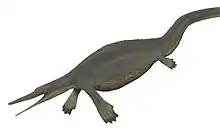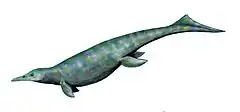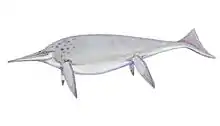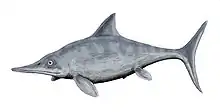Undorosaurus
Undorosaurus is an extinct genus of ophthalmosaurid ichthyosaur known from western Russia, Svalbard, and Poland.[1][4][2]
| Undorosaurus | |
|---|---|
)_%D0%9C%D1%83%D0%B7%D0%B5%D0%B9_%D0%BF%D0%B0%D0%BB%D0%B5%D0%BE%D0%BD%D1%82%D0%BE%D0%BB%D0%BE%D0%B3%D0%B8%D0%B8._%D0%A3%D0%BD%D0%B4%D0%BE%D1%80%D1%8B._%D0%A3%D0%BB%D1%8C%D1%8F%D0%BD%D0%BE%D0%B2%D1%81%D0%BA%D0%B0%D1%8F_%D0%BE%D0%B1%D0%BB._%D0%9D%D0%BE%D1%8F%D0%B1%D1%80%D1%8C_2013_-_panoramio.jpg.webp) | |
| Recosntructed skeleton | |
| Scientific classification | |
| Kingdom: | Animalia |
| Phylum: | Chordata |
| Class: | Reptilia |
| Order: | †Ichthyosauria |
| Family: | †Ophthalmosauridae |
| Subfamily: | †Platypterygiinae |
| Genus: | †Undorosaurus Efimov, 1999 |
| Type species | |
| †Undorosaurus gorodischensis (Efimov, 1999) | |
| Other species | |
| Synonyms | |
| |
Etymology
Undorosaurus was named by Vladimir M. Efimov in 1999 and the type species is Undorosaurus gorodischensis. The specific name is named after Gorodische, the type locality of this taxon.[4] U. trautscholdi is named in honor of the geologist H. Trautschold who collected and made the first description of the fossils of the holotype of the species.[2]
Discovery and Classification
Undorosaurus was first known from the holotype UPM EP-II-20 (527), a partial three-dimensionally preserved skeleton which preserved partial skull. It was collected near the Volga river at Gorodische from the Epivirgatites nikitini ammonoid zone, dating to the Late Jurassic.[4] A second species, U. trautscholdi was described by M.S. Arkhangelsky and N.G. Zverkov in 2014 from a partial left forefin found in the locality of Mnevniki, in the Moscow Oblast.[2]
Maisch and Matzke (2000) regarded Undorosaurus to be a species of Ophthalmosaurus.[5] However, Storrs et al. 2000 rejected this synonymy based on the tooth morphology of the specimen.[6] Chris McGowan and Ryosuke Motani (2003) pointed out two noteworthy differences to Ophthalmosaurus, an incompletely fused ischiopubis and a remarkably strong dentition, and considered Undorosaurus to be a valid genus of ophthalmosaurid.[7] Undorosaurus's validity is now accepted by most authors, even by Maisch (2010) who originally proposed the synonymy.[8][9][10]
Zverkov & Efimov (2019) considered the genus Cryopterygius to be a junior synonym of the genus Undorosaurus. The authors considered the type species of the former genus, C. kristiansenae, to be synonymous with Undorosaurus gorodischensis; second species of Cryopterygius, C. kielanae, was tentatively maintained by the authors as a distinct species within the genus Undorosaurus.[11]
The following cladogram shows a possible phylogenetic position of Undorosaurus in Ophthalmosauridae according to the analysis performed by Zverkov and Jacobs (2020).[12]
| Ophthalmosauria |
| ||||||||||||||||||||||||||||||||||||||||||||||||||||||||||||||||||||||||||||||||||||||||||||||||||||||||||||||||||||||||||||||||||||||||||||||||||||||||||||||||||||||||||||||||||||||||||||||||||||||||||||||||||||||||
References
- "†Undorosaurus Efimov 1999". Paleobiology Database. Fossilworks. Retrieved 5 January 2016.
- M.S. Arkhangelsky and N.G. Zverkov (2014). "On a new ichthyosaur of the genus Undorosaurus" (PDF). Proceedings of the Zoological Institute of the Russian Academy of Sciences. 318 (3): 187–196.CS1 maint: uses authors parameter (link)
- Daniel Tyborowski (2016). "A new ophthalmosaurid ichthyosaur from the Late Jurassic of Owadów-Brzezinki Quarry, Poland". Acta Palaeontologica Polonica. in press. doi:10.4202/app.00252.2016.
- Vladimir M. Efimov (1999). "A new family of Ichthyosaurs, the Undorosauridae fam. nov. from the Volgian stage of the European part of Russia". Paleontological Journal. 33 (2): 174–181.CS1 maint: uses authors parameter (link)
- Michael W. Maisch and Andreas T. Matzke (2000). "The Ichthyosauria" (PDF). Stuttgarter Beiträge zur Naturkunde: Serie B. 298: 1–159.
- Storrs, Glenn W.; Vladimir M. Efimov; Maxim S. Arkhangelsky (2000). "Mesozoic marine reptiles of Russia and other former Soviet republics". In Benton, M.J.; Shishkin, M.A.; Unwin, D.M. (eds.). The Age of Dinosaurs in Russia and Mongolia. Cambridge: Cambridge University Press. pp. 140–159. ISBN 9780521545822.
- McGowan C, Motani R. 2003. Ichthyopterygia. – In: Sues, H.-D. (ed.): Handbook of Paleoherpetology, Part 8, Verlag Dr. Friedrich Pfeil, 175 pp., 101 figs., 19 plts; München
- Michael W. Maisch (2010). "Phylogeny, systematics, and origin of the Ichthyosauria – the state of the art" (PDF). Palaeodiversity. 3: 151–214.CS1 maint: uses authors parameter (link)
- Fischer, V.; A. Clement; M. Guiomar; P. Godefroit (2011). "The first definite record of a Valanginian ichthyosaur and its implications on the evolution of post-Liassic Ichthyosauria". Cretaceous Research. 32 (2): 155–163. doi:10.1016/j.cretres.2010.11.005.
- Fischer, V.; Masure, E.; Arkhangelsky, M.S.; Godefroit, P. (2011). "A new Barremian (Early Cretaceous) ichthyosaur from western Russia". Journal of Vertebrate Paleontology. 31 (5): 1010–1025. doi:10.1080/02724634.2011.595464.
- Nikolay G. Zverkov; Vladimir M. Efimov (2019). "Revision of Undorosaurus, a mysterious Late Jurassic ichthyosaur of the Boreal Realm". Journal of Systematic Palaeontology. 17 (14): 963–993. doi:10.1080/14772019.2018.1515793.
- Nikolay G. Zverkov; Megan L. Jacobs (2020). "Revision of Nannopterygius (Ichthyosauria: Ophthalmosauridae): reappraisal of the 'inaccessible' holotype resolves a taxonomic tangle and reveals an obscure ophthalmosaurid lineage with a wide distribution". Zoological Journal of the Linnean Society. Online edition. doi:10.1093/zoolinnean/zlaa028.




